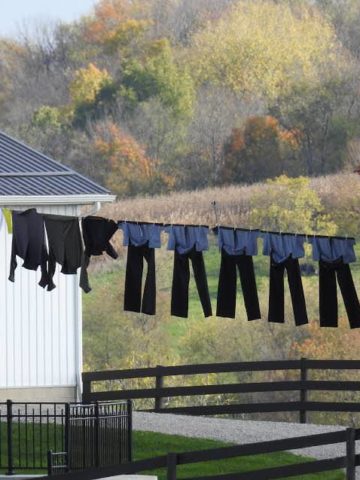CAPTION: Photos by Traditional Arts Indiana, dolls on Kathryn Lengacher's work table.
Amish children only play with faceless dolls, true or false?
In reality, either answer is probably true some of the time. As with almost any topic concerning the Amish there is no one-size-fits-all answer and a lot of nuance. A common refrain I hear is that the Amish don't use mirrors (not true, that is a topic for another time) and that Amish children only play with faceless dolls. For the most part, Amish people don't want to be photographed citing Exodus 20:4 King James Version's verse "Thou shalt not make unto thee any graven image, or any likeness of any thing that is in heaven above, or that is in the earth beneath, or that is in the water under the earth:" That interpretation has generally just been applied to live people, not to dolls. I've seen first-hand plenty of Amish children playing with dolls that have faces. Keep in mind the Amish are Anabaptists, they are not officially church members until they are adults, so the children have a lot more latitude in what they do and what they don't do than the adults. Again, I can only convey my personal experience, having been in scores of Amish homes over the years and I've seen plenty of Amish children playing with plastic non-Amish dolls from large companies like Mattel or Hasbro.
Some ultra-conservative or more conservatively ideological Amish would perhaps not let their children play with dolls that have faces, but that, in my experience, is more of an individual parental issue and less of a church issue.
Faceless dolls, however. have become popular in pop culture regarding the Amish and that bumped up their popularity among some Amish. It is interesting in the interview that the Amish woman stresses that the collectors are really the ones that don't want the faces on the dolls.
That said, would I want to own a hand-crafted doll made by an Amish artisan? Absolutely! A ton of care, tradition, and history is infused in such a creation, driven by generations of skill passed down from grandmothers to granddaughters and on and on.
Traditional Arts Indiana, a wonderful collaboration between Indiana University and the Indiana Arts Commission, conducted a rare audio interview with an Amish doll-maker which I'll share with you here. The interview is with Kathryn Lengacher of Grabill, Indiana. The interview is 11 minutes long, click on the lower right side under the word FILES. And here, Traditional Arts Indiana offers a wonderful step-by-step slideshow of how Kathryn pieces together the Amish dolls.
She explains how her dolls have more realistically rounded heads than the more traditional flat-headed Amish dolls made with two-pieces of fabric.
Lengacher, by the way, is a very localized name within the Amish church. It's most common in the Grabill, Indiana settlement. I'm not sure of the full history, but my guess is that the name is a relatively recent (meaning 100 years or so ago) convert to the church.
http://digitalarchive.traditionalartsindiana.org/items/show/1231





Deanna Sofia Gordinier
I was so glad to have the mirror myth cleared up. And the doll history is quite interesting. I am surprised to hear of the non Amish dolls the children get to choose from. They could choose faces as Raggedy a Ann & Andy have on a round headed Amish doll. Just a thought. I'm not here to judge. I appreciate all that you do Mr. Kevin.
Deanna Sofia Gordinier
I love the history lesson I got with Kathryn Lengacher. I felt bad not leaving the comment to her wonderfully detailed lesson that is even in a Museum! What a delight.